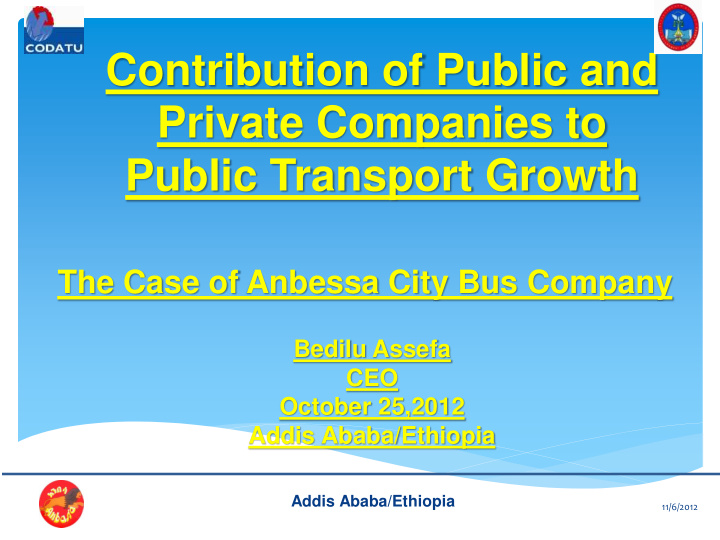



Contribution of Public and Private Companies to Public Transport Growth The Case of Anbessa City Bus Company Bedilu Assefa CEO October 25,2012 Addis Ababa/Ethiopia Addis Ababa/Ethiopia 11/6/2012
Overview 1 Addis Ababa:-Transport Related Facts 2 The Public Transport 3 The Bus Services 4 The Major Contributions 5 The Challenges 6 The Way Forward 11/6/2012 Addis Ababa/Ethiopia
1. Addis Ababa Transport Related Facts Total area about 540km 2 Population 3 Million with an annual rate of growth 2.9% Average house hold size 5.8 persons Expenditure on transport 9.1% Per capita income 6857br (298Eu) The Share of economic activities to the city GDP 74.9 service, 24.6 industry 0.35 agriculture (Urban) 11/6/2012 Addis Ababa/Ethiopia
Continued….. Average trip generated daily … ..3.4 Million/Person trip Modal Share is assumed as:- - 55% Walking - 16% Buses - 24% Taxis - 5% other Vehicles 11/6/2012 Addis Ababa/Ethiopia
2. The Public Transport Public transport is a shared passenger transport service for use of the general public. The major public transport service providers are:- Anbessa City Bus, the mid-bus the mini-bus taxis, Except Anbessa, the other public transports are not yet formed as companies. 11/6/2012 Addis Ababa/Ethiopia
The Modal Share (Daily average) Of Public Transport Passenger PT-mode Seating Fleet Share Carried Capacity size % daily Mini Bus Taxi 11 10,500 1.6 million 73% Midi Bus (Higer) 25 439 180,000 8% Anbessa Bus 100 750 420,000 19% Total - - 2.2 million 100% Note: 150 Articulated buses carry 170 each Source: Bureau’s report 11/6/2012 Addis Ababa/Ethiopia
3. The Bus Services Currently the fleet size is 759 (300 old DAF buses & 459 new buses) The types of services • Standard Scheduled Service (70%) • Feeder Service (10%) • Special (Premium) Service (20%) Operating hour-13 (two Shifts) Time table for the Scheduled Service 11/6/2012 Addis Ababa/Ethiopia
Four Terminals used as Origin - destination No Terminal Bus routes No. of Direction Buses 1. Merkato 40 154 West-Central 2. Lagare 31 132 South-Central 3. Gergois 21 87 North 4. Megenagna 12 42 East 11/6/2012 Addis Ababa/Ethiopia
The Ridership An Average of 1.1 million trips are made by the buses every year. About 8% of the trip connects the sub-urban commuters to the city. Daily ridership is about 400,000 Commuters Daily KM run (for the Scheduled Service) about 48,589 11/6/2012 Addis Ababa/Ethiopia
Anbessa’s 5 Years Ridership ( million ) 160 160 154 154 150 150 140 140 128 128 130 130 120 120 108 108 110 110 100 100 102 102 98 98 90 90 80 80 2007 2007 2008 2008 2009 2009 2010 2010 2011 2011 11/6/2012 Addis Ababa/Ethiopia
The Fare Structure Distance Fare Area Regulated by the Federal USD Transport Authority (FTA) • < 5kms. 0.06 Short distance Based on distance • 5-9 kms. 0.08 City center • 9-12 kms ‘’ 0.11 categorized in to eight • 12-18 ‘’ ‘’ 0.14 groups. • 18- 21 ‘’ 0.19 City boundary Flat fare for each group • 21- 24 ‘’ ‘’ 0.22 • 24- 30 ‘’ Discount fare for mid- 0.26 Suburb • 30- 47‘’ ‘’ 0.43 distance travelers 11/6/2012 Addis Ababa/Ethiopia
4. The Major Contributions Bus Commuters have spent an average of over 53,977 USD to the economy in 2011. Students and low income groups are frequent bus users and depend on the bus to Access education & work. People are connected with jobs, shopping centers, social service centers … In religious holidays alone the number of commuters is twice as much as the normal working day. 11/6/2012 Addis Ababa/Ethiopia
Continued….. Buses assist the efficiency of the labor market. About 19% of the service is rendered for commuters of the road constriction & Housing Projects. About 26% of the service is assigned to support the vitality of Shopping centers (Specially Merkato) 11/6/2012 Addis Ababa/Ethiopia
Continued….. 3800 people are employed by the bus company and about 5.6 million used is spent in the economy. Knowledge transfer is enhanced in the automotive industry as a result of the bus operation. About 65% of the buses are assembled in the country. Although the cost of congestion is not yet surveyed, the buses offer cost effective way to reduce congestion. 11/6/2012 Addis Ababa/Ethiopia
5. The Major Challenges Access to spare parts The bus-priority agenda (lanes, terminals … ) The problem of congestion-the traffic management system The attitude towards the public transport The capacity of maintaining & attracting the workforce 11/6/2012 Addis Ababa/Ethiopia
6. The way forward Strengthening the reform program The introduction of new systems and technologies (Fleet management, Automatic Fare Collection, Maintenance Management) Introduction of environment friendly buses Capacity building programs 11/6/2012 Addis Ababa/Ethiopia
11/6/2012 Addis Ababa/Ethiopia
Recommend
More recommend